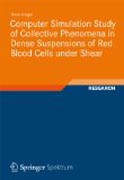
Computer simulation study of collective phenomenain dense suspensions of red blood cells under shea
Krüger, Timm
The rheology of dense red blood cell suspensions is investigated via computersimulations based on the lattice Boltzmann, the immersed boundary, and the finite element methods. The red blood cells are treated as extended and deformable particles immersed in the ambient fluid. In the first part of the work, thenumerical model and strategies for stress evaluation are discussed. In the second part, the behavior of the suspensions in simple shear flow is studied fordifferent volume fractions, particle deformabilities, and shear rates. Shear thinning behavior is recovered. The existence of a shear-induced transition from a tumbling to a tank-treading motion is demonstrated. The transition can beparameterized by a single quantity, namely the effective capillary number. Itis the ratio of the suspension stress and the characteristic particle membrane stress. At the transition point, a strong increase in the orientational order of the red blood cells and a significant decrease of the particle diffusivity are observed. However, the average cell deformation shows no signature of the transition. INDICE: Complex fluids and their rheology.- Physics of red blood cells andhemorheology.- Numerical model for simulations of red blood cell suspensions.- Physical considerations and ingredients for the numerical model.- Fluid solver: the lattice Boltzmann method.- Fluid-structure interaction: the immersed boundary method.- Membrane model and energetics.- Stress evaluation in combinedimmersed boundary lattice Boltzmann simulations.- Rheology and microscopic behavior of red blood cell suspensions.
- ISBN: 978-3-8348-2375-5
- Editorial: Springer
- Encuadernacion: Rústica
- Fecha Publicación: 13/07/2012
- Nº Volúmenes: 1
- Idioma: Inglés
